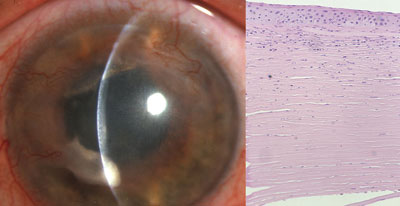Corneal transplant rejection attributed to pre-existing inflammation
Inflammation is closely linked to protein biomarkers and clinical neovascularization, study shows.
Subclinical inflammation is associated with increased risk of transplant rejection in patients undergoing penetrating keratoplasty for herpes simplex virus keratitis, according to a study.
“Histopathologic evidence of inflammation in excised corneal tissues indicated a much higher risk of rejection for the new corneal transplant,” corresponding author Victor M. Elner, MD, PhD, said in an interview with Ocular Surgery News.
Inflammation was linked to the presence of immune receptors and secreted biomarkers, the study authors said.
The study comprised a prospective, pathologic evaluation of tissue and retrospective chart review that included 62 patients with herpes simplex virus keratitis who underwent PK. Average disease duration was 19 years. Subsequently, the authors followed patients for an average of 43 months.
The authors conducted in vitro enzyme-linked immunosorbent assay testing for interleukin-8 (IL-8), monocyte chemotactic protein-1 (MCP-1) chemokines, and immunohistochemical staining for intercellular adhesion molecule-1 (ICAM-1) antigens and human leukocyte antigen (HLA)-DR in inflamed and non-inflamed host tissue specimens, Dr. Elner said.
Clinically quiet disease
“We examined a large cohort who had a history of herpes simplex viral keratitis who underwent rehabilitation of their eye with corneal allografts,” Dr. Elner said. “What we found is that even though the large majority, over 80%, of the patients had clinically quiet disease — in other words, where corneal inflammation was not seen by the clinician — only 26% really had no visible inflammation when we looked at the tissue microscopically. Therefore, there was subclinical inflammation in a large percentage of the patients.”
|
Image: Elner VM |
Study data showed that 81% of patients had clinically inactive disease. However, 74% of patients had active corneal inflammation upon pathologic analysis, and 34% experienced allograft rejection, he said.
Histopathologic presence of inflammation showed a statistically significant correlation to allograft rejection ( P = .02), the authors said. Also, examination showed that tissue specimens with inflammation had markedly elevated levels of IL-8 (P = .0005) and MCP-1 (P = .003). The samples also showed higher immunoreactivity for HLA-DR and ICAM-1 than non-inflamed specimens.
“We found that two secreted proteins that elicit the inflammatory cells to come into the cornea, IL-8 and MCP, were also elevated,” Dr. Elner said. “All of the biomarkers were elevated in grafts that showed evidence of histopathologic inflammation when compared to corneas that showed no inflammation.”
Data also showed a statistically significant association between active corneal inflammation and clinical neovascularization (P = .01).
“We found that where there was inflammation, there was more evidence of blood vessel growth that might predispose to allograft rejection,” he said.
Risk of graft rejection
Survival analysis results indicated an increasing risk of graft rejections over time among those with microscopic inflammatory signs, Dr. Elner said.
“The Kaplan-Meier curves based on the data indicate that over 50% of patients with inflammation eventually would be predicted to have a graft rejection after 8 years,” he said. “So there’s an over 50% long-term risk of rejection in patients who have microscopic inflammation in the pathology.”
The anti-inflammatory cytokine, IL-10, was used as an experimental treatment to suppress inflammation in the excised grafts and resulted in reductions of IL-8 and MCP that were statistically significant (P = .006 and P = .01, respectively).
Studying inflammation-related graft rejection after Descemet’s stripping endothelial keratoplasty, an alternative to PK, may be worthwhile, Dr. Elner said.
“It would be interesting to see whether complications of DSEK related to inflammation might lead to a higher incidence of rejection,” he said. “It would take some time to collect enough tissue samples to show statistical significance, however.” – by Matt Hasson
Reference:
- Shtein RM, Garcia DD, Musch DC, Elner VM. Herpes simplex virus keratitis: histopathologic inflammation and corneal allograft rejection. Ophthalmology. 2009;116(7):1301-1305.
- Victor M. Elner, MD, PhD, can be reached at University of Michigan, Kellogg Eye Center, 1000 Wall St., Ann Arbor, MI 48105; e-mail: velner@umich.edu.

![]()
A high percentage of corneas with clinically quiescent herpes simplex virus actually exhibited signs of inflammation by histopathologic analysis following penetrating keratoplasty. Furthermore, the presence of inflammation was associated with a seven-time higher risk of subsequent allograft rejection episodes. This suggests that the clinician could tailor the postoperative anti-rejection regimen for individual patients based on the pathology findings on the explanted host tissue. In addition, further investigation of preoperative anti-inflammatory agents that might reduce the risk of subsequent allograft rejection is warranted based on the results of this study.
– Marianne O. Price, PhD
Executive
Director, Cornea Research Foundation of America, Indianapolis

